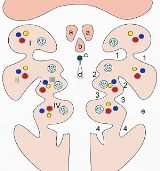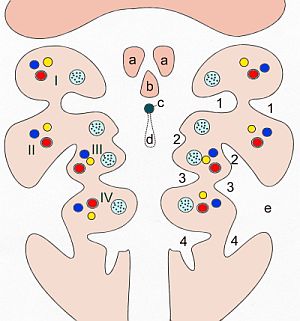
Tuberculum impar
Encyclopedia

Wilhelm His, Jr.
Wilhelm His, Jr. was a Swiss-born cardiologist and anatomist.He was born on December 29, 1863 to Wilhelm His, Sr.. In 1893, he discovered the bundle of His, which is a specialized tissue in the heart that transmits the electrical impulses and helps synchronize contraction of the cardiac muscles...
as undergoing enlargement to form the buccal part of the tongue.
More recent researches, however, show that this part of the tongue is mainly, if not entirely, developed from a pair of lateral swellings
Lateral lingual swelling
During the third week there appears, immediately behind the ventral ends of the two halves of the mandibular arch, a rounded swelling named the tuberculum impar, which was described by His as undergoing enlargement to form the buccal part of the tongue...
which rise from the inner surface of the mandibular arch and meet in the middle line. The site of their meeting remains post-embryonically as the median sulcus of the tongue
Median sulcus of the tongue
The dorsum of the tongue is convex and marked by a median sulcus, which divides it into symmetrical halves.This sulcus ends behind, about 2.5 cm. from the root of the organ, in a depression, the foramen cecum, from which a shallow groove, the sulcus terminalis, runs lateralward and forward on...
.
The tuberculum impar is said to form the central part of the tongue immediately in front of the foramen cecum
Foramen cecum (tongue)
The dorsum of the tongue is convex and marked by a median sulcus, which divides it into symmetrical halves; this sulcus ends behind, about 2.5 cm from the root of the organ, in a depression, the foramen cecum , from which a shallow groove, the sulcus terminalis, runs lateral and anterior on either...
, but Hammar insists that it is purely a transitory structure and forms no part of the adult tongue.

